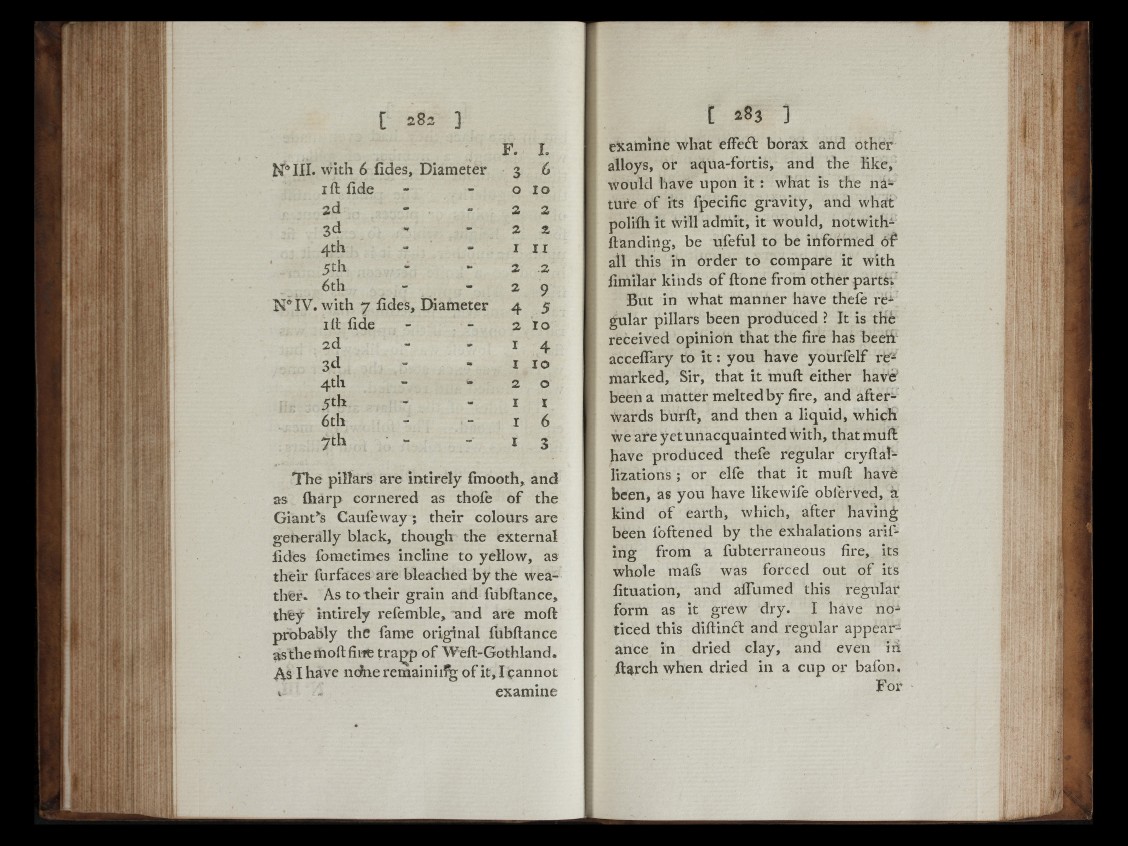
i l
Bì ■( ;'rrii -7r i'
ì’i ;
Al:
h
Ari
,i>| A-
Bri
‘E[ 1 ■ ; li'
VMM 'A''
ririA' ;G ^ A
M AA ;
ri ■r i B ' ■ ■ ^ * ri ■ ft =
'M '
f! »?
■ijfe:l !1''
"G ì
W'i'M •' ;-¡á| ‘
[ 282 ]
K'^IiL with 6 iides, Diameter
I ft iide
2d - «
3d -
4th
5th
6th
N*IV. with 7 iides. Diameter
lit iide
2d - -
3d
4th
5th
6th
7th
F. L
3 6
0 10
2 2
2 2
I I I
2 .2
2 9
4 , 5
2 i o
I 4
I IO
2 0
I I
I 6
I 3
The pillars are intirely fmooth, and
as fliarp cornered as thofe o f the
Giant’s Caufe way ; their colours are
generally black, though the external
iides fometimes incline to yellow, as
their furfaces are bleached by the weather.
As to their grain and fubftance,
they intirely refemhle, and are moft
probably the fame original fubftance
as the moft fine tra^p o f Weft-Gothland.
As I have ndnereniainii% o f it, I cannot
examine
[ 283 ]
examine what eifeét borax and other
alloys, or aqua-fortis, and the like,
would have upon it : what is the nature
o f its fpecific gravity, and what
polifli it will admit, it would, notwithftanding,
be ufeful to be informed o f
ail this in order to compare it with
iimilar kinds o f ftone from other parts;
But in what manner have thefe regular
pillars been produced ? It is the
received opinion that the fire has beeil
acceflary to it : you have yourfelf remarked,
Sir, that it muft either havè^
been a matter melted by fire, and afterwards
burft, and then a liquid^ which
we are yet unacquainted with, that muft
have produced thefe regular cryftal-
lizations ; or elfe that it muft have
been; as you have likewife obferved, a
kind o f earthi which, after having
been ibftened by the exhalations arifing
from a fubterraneous fire, its
whole mafs was forced out o f its
fituation, and aftumed this regular
form as it grew dry. I have noticed
this diílinél and regular appearance
in dried clay, and even iii
ftarch when dried in a cup or bafon.
For
ft' ill*
I'** '
f f / ‘
AU;
i lm
A*:. -'Gi
f tV '" riri' '"riri & r i a
r i r i ' " " - r i l l . ; ,
lA ' 'rii üflA!.. ‘ "A
" mm fr i
t ib
V.